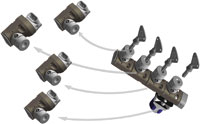
Posted to News on 20th Mar 2015, 00:00
Meeting fault masking standards using trapped keys
Rob Lewis of Fortress Interlocks looks at the options to prevent fault masking.

>The long discussed phenomenon of fault masking (unintended resetting) when connecting multiple volt-free contacts in series into a safety monitoring device is covered in EN ISO 14119 and an associated technical report. In simple terms, if gate switches are wired in series, then it is still possible to reset the safety circuit even after a short circuit has occurred on one part of the circuit, as one of the other gate switches can still open both circuits allowing the fault to be cleared from the safety relay or PLC.
>The effect is so pronounced that for a system with more than one frequently opened guard the level of Diagnostic Coverage (DC) falls to zero, resulting in a performance level (PL) reduction to a maximum of PLc.
>To prevent this reduction in PL there are three solutions:
>1. Do not use series wiring (daisy chain wiring), instead use a safety relay for every interlock
>2. Use interlocks which incorporate built-in diagnostics or network diagnostics
>3. Use a trapped key interlock system that can open multiple doors from just one switch.
>Options 1 and 2 come with quite a cost impact, so how can trapped key overcome the issue? In the illustration four locks are mechanically linked to a single force break switch with dual, normally closed, contacts. These contacts cannot be closed until all keys are returned to the unit, and in reverse it is impossible to remove a single key without breaking the contacts. Once the keys are released they go to the four door locks. Only with the key in the door lock can you open the door and, with the door open, the key is trapped in the lock (and so unable to return to the switch unit).
>Because there is only one set of safety contacts, there is no risk of fault masking and only one set of safety I/O is required to cover the whole cell. Another benefit of this system is that the switch can be mounted wherever it is most convenient (not necessarily at the door), allowing the unit to be mounted at the main control panel, significantly reducing wiring costs. The Fortress mGard Trapped Key product range offers TUV approval to PLe.
>In my opinion, a trapped key interlock system is ideal in meeting fault masking standards set out in EN ISO 14119. It has advantages over using safety relays, or incorporating built-in diagnostics, in that it saves on the number of safety I/O required and results in large savings in wiring costs.








